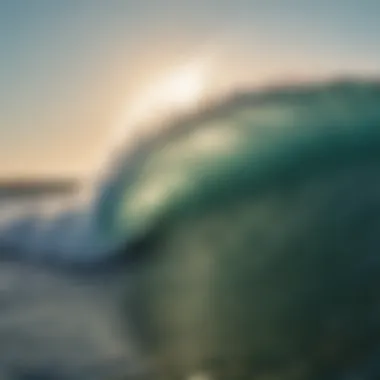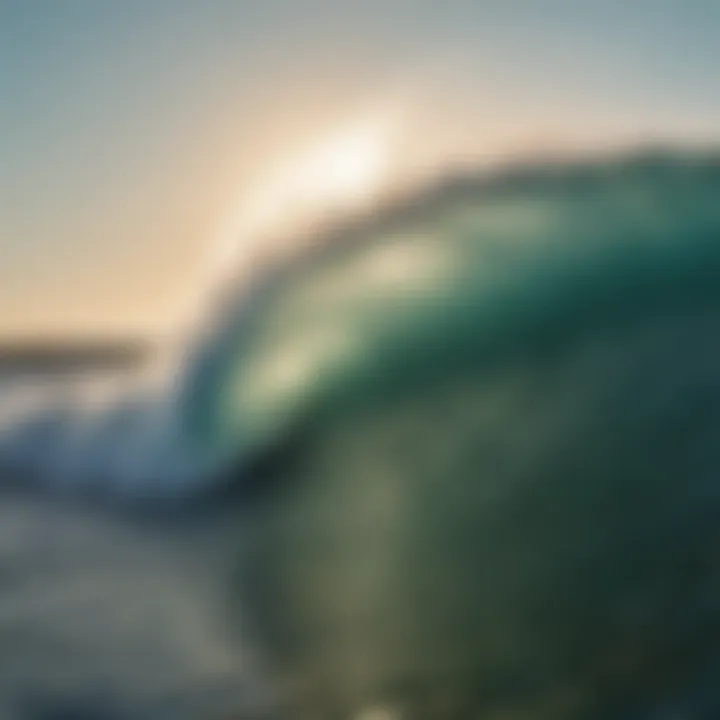Essential Insights into Tide and Swell Forecasts


Intro
Understanding tide and swell forecasts is integral for any water sports enthusiast, be it a surfer chasing the perfect wave or a sailor navigating the open sea. The ocean is a dynamic environment, shaped by a multitude of factors that interplay, affecting everything from the size of swells to tidal heights. By grasping how these elements function, individuals can significantly enhance their safety and performance while engaging with water activities.
This guide unfolds the intricate behavior of tides and swells, beginning with basic concepts before delving into forecasts and methodologies. We’ll examine crucial techniques for both novices and seasoned athletes, ensuring that readers of all experience levels feel equipped to tackle the water confidently.
As we venture further, we won’t shy away from discussing essential safety measures to consider while out on the water, nor will we overlook the gear that can be pivotal for performance and protection. Throughout, we'll highlight the relationship between local conditions and the broader oceanic phenomena that affect every water sports enthusiast. By the time you reach the end of this guide, you'll have a comprehensive understanding of how to optimize your time in the water, keeping safety and enjoyment at the forefront of every aquatic adventure.
Foreword to Tide and Swell
Understanding the complex interplay of tide and swell is not just an academic pursuit; it’s a lifeline for those who thrive in water-based activities. For surfers, sailors, and even kayakers, the rhythm of the ocean is as crucial as the skills they hone on their chosen boards or in their vessels. Among water sports enthusiasts, knowledge of tides and swells can dictate the success of an outing and, more importantly, ensure safety.
The Importance of Accurate Forecasting
Accurate forecasting of tides and swells embodies more than mere prediction—it's about understanding the pulse of the ocean. A reliable tide forecast helps in planning the safest and most enjoyable times to embark on aquatic adventures. When individuals know when to expect high or low tides, they can adjust their activities accordingly. For instance, surf aficionados often aim for conditions with favorable swell, timing their sessions just right to ride the waves effectively.
Moreover, knowing how accurate tide and swell forecasts can influence sailing is equally significant. Sailors navigate using wind patterns, coupled with tide flows. The merging of these elements is what sets the stage for smoother voyages and more enjoyable experiences at sea. An understanding of how these currents work also provides insights into the challenges one might face at different points along a coastline.
The technology at play in forecasting has taken huge strides recently. With apps and websites providing real-time data, outdoor adventurers are equipped like never before. This is particularly pertinent during seasonal changes or when weather events come into play.
Understanding Water Movement
Water movement is a dance of physics and nature that is shaped by many factors. It’s not just about waves crashing on the beach; it’s the intricate ballet of gravitational forces, local winds, and atmospheric pressure that creates the conditions we observe. Eddies, currents, and swells evolve constantly, making the ocean a dynamic environment.
The mechanics behind water movement can seem complex, but the results are tangible and observable. For example, when a strong wind blows across a vast body of water, such as in the case of a storm, swells can be generated that travel long distances. The energy imparted by the wind creates waves that can arrive at distant shores, affecting surf conditions in ways that might not be immediately apparent.
To dive deeper into the interplay of local elements, consider how geographical features like bays and inlets can modify wave behaviors. These factors contribute to a localized experience, changing conditions minute by minute, creating ideal or hazardous scenarios for any water sports enthusiast.
Understanding the nuances of water movement not only aids in choosing the right time for water activities but it also cultivates a sense of respect for the power of the ocean. As with any outdoor pursuit, knowledge breeds safety, and familiarity with the ebb and flow of the tides enriches one’s connection with nature, enhancing the overall experience on the water.
The Science Behind Tides
Understanding the science behind tides is not just an academic exercise; it’s an essential component for anyone who spends time on the water, whether for sport or leisure. Grasping the underlying physical processes can elevate one’s ability to predict conditions, ensuring safe and enjoyable experiences. At the heart of tidal science are gravitational interactions, cyclical patterns, and various local factors that can modify the expected tidal behavior. This knowledge helps water sport enthusiasts optimize their activities, plan their outings accordingly, and even enhance their safety while engaging with the ocean.
Gravitational Forces and Their Effects
The fundamental concept behind tides lies in gravitational forces, primarily between the Earth, the Moon, and the Sun. When the Moon orbits our planet, it exerts a pull, causing water to bulge on the side facing the Moon and, interestingly, also on the opposite side due to a centrifugal effect. This tug-o-war creates what is known as the tidal cycle, leading to high tides in these bulged areas.
Key Points about Gravitational Influence:
- The Moon’s gravitational force is approximately twice as impactful on tides as the Sun’s.
- High tides occur roughly every 12 hours, while the timing can shift daily, influenced by the Moon’s position relative to Earth.
- The distance and angle of the Sun and Moon can amplify or diminish tidal ranges, creating spring and neap tides, respectively.
In simple terms, this means that when planning a surf session or a sailing trip, one must consider these celestial movements. The nuances of gravitational changes can provide insight into the expected tidal heights and times, thereby allowing enthusiasts to plan their activities with precision.
Tidal Patterns and Cycles
Tides are not merely random events; they follow a rhythm dictated by gravitational forces and Earth’s rotation. The tidal patterns form an intricate cycle influenced by various factors:
- Diurnal Tides: These are characterized by one high tide and one low tide each lunar day. This phenomenon is seen in regions like the Gulf of Mexico.
- Semi-diurnal Tides: This is the most common pattern, featuring two high tides and two low tides per lunar day, typical in the eastern United States.
- Mixed Tides: As the name implies, this pattern combines elements from both diurnal and semi-diurnal tides, with variations throughout the day and month.
Understanding these cycles is crucial for water enthusiasts; it can allow them to predict when the water will be at its best—be it to surf the perfect wave or to find calmer waters for sailing.
Local Influences on Tidal Behavior
While gravitational forces govern the larger tidal movements, local geography and seafloor topography significantly modify these tides. Here are some noteworthy factors:
- Coastal Configuration: The shape of the coastline can either amplify or diminish wave action and tidal flow. For instance, narrow bays can cause water to rise significantly high as it funnels into confined spaces.
- Land Features: Mountains and islands can block tidal movements, resulting in varied tide levels over short distances.
- Human Influence: Construction projects, channel modifications, and other alterations can interfere with natural tidal patterns, creating unexpected conditions for water sports.
"Local knowledge is your secret weapon. Understanding how your specific area reacts to global forces can give you an edge in optimizing your time on the water."
Being mindful of these local influences, athletes can not only raise their chances of a thrill-filled outing but also stay safe by being aware of changing conditions well in advance. Overall, the interplay between global tidal forces and local geography paints a complex yet vital picture for anyone keen on engaging with the sea.
The Nature of Ocean Swells
Understanding ocean swells is essential for any water sports enthusiast. Swells not only dictate the conditions for activities like surfing and sailing, but they also affect safety and performance on the water. Knowing how swells form and behave can significantly enhance your experience, leading to better-informed decisions while engaging in aquatic sports.
Swells are long-lasting waves that travel through the ocean, often formed by distant storms. Unlike wind waves, which are smaller and more chaotic, swells move steadily and predictably over great distances. This article will explore the fundamentals of swells, elucidating how they are generated, their energy transmission, and the various types that exist. This understanding is akin to knowing the lay of the land—once you grasp these concepts, you'll be better equipped for adventures on the water.
Generating Swells: Wind and Distance
The generation of ocean swells primarily hinges on two factors: wind strength and the distance over which it blows, often referred to as the "fetch." When wind blows across the surface of the sea, it transfers energy to the water, creating waves. If this wind persists over a significant distance, swells begin to form. Stronger winds contribute to bigger swells.


- Wind Speed: Faster winds create more energy, leading to larger waves. A gentle breeze won’t work up much more than ripples; think of it like trying to make a cake with just water and flour—you're not gonna get a good result without the right ingredients.
- Fetch: The longer the stretch of water that the wind interacts with, the more organized and larger the swell. Imagine a chef mixing the batter continuously; if he has more room to work, the result is often smoother.
In essence, both of these elements play a vital role in swell formation. Effective predictions of swell size and direction can help enthusiasts plan their activities accordingly.
Wave Period and Energy Transmission
Wave period refers to the time it takes for two successive wave crests to pass a fixed point. In the world of swells, this period tells us a lot about the energy behind these waves. The longer the wave period, the more energy it carries, which directly influences the shape and power of the wave when it reaches shore.
- Energy Transfer: As swells travel, they transfer energy through the water column, impacting its depth. Waves with a longer period tend to have a deeper reach, allowing them to maintain strength over long distances.
- Impact on Surfing: Surfers, for instance, will often prefer swells with longer wave periods as these can produce more powerful rides. In this context, knowing the wave period can be compared to understanding the "swing" of a pendulum; a longer swing has a greater reach.
The interplay of wave period and energy transmission is crucial for anyone looking to harness the ocean’s power, as it allows for a more strategic approach to timing and location when catching waves.
Different Types of Swells
Swells come in various forms, each influenced by source and the local conditions they encounter. Recognizing the type of swell can significantly affect planning for water activities.
- Ground Swells: These are generated by storms far offshore and travel efficiently across the ocean. They result in smooth, powerful waves that many surfers seek out.
- Wind Swells: These originate from local winds and are usually short-lived and choppy. They can be unpredictable and less desirable for serious surfers but might be fun for beginners.
- Mixed Swells: A combination of ground and wind swells, these types can create interesting wave patterns that require experience to navigate effectively.
Understanding these fundamentals won't just help in selecting the right day for your activities; they can also assist in comprehending the challenging sea conditions that may arise unexpectedly. Knowledge of swells, like knowing the rules of a great game, enables you to enjoy the sport more while minimizing risks.
Forecasting Tools and Technology
In the relationship between tide and swell phenomena, the tools and technology we use to forecast these elements play a crucial role. For watersport enthusiasts, having access to precise forecasts can be the difference between an enriching day on the water and an experience fraught with unexpected challenges. By leveraging modern technology, enthusiasts can gain insights that enhance their safety and enjoyment.
*
Digital Tide Tables and Applications
Digital tide tables have become invaluable for anyone who spends time near the coast. These online platforms or mobile applications provide users with easy access to detailed tide schedules that are updated frequently. The benefit of using digital tide tables is clear: accuracy and timeliness. Instead of flipping through thick books, tidal data can now be retrieved in the blink of an eye, often accompanied by interactive maps for better visualization.
One notable app in this space is Tides Planner, which offers customizable notifications for high and low tides tailored to specific locations. It also integrates weather data, letting users just keep their eyes on a single screen. Another option is Tide Chart, which caters specifically to fishermen and boaters by highlighting the best fishing times along with tidal data.
"Using digital tide tables can feel like having a personal guide to the ocean's rhythm, allowing you to align your adventures with nature's schedule."
Real-Time Wave Condition Trackers
When it comes to the world of surfing and other wave-based sports, real-time wave condition trackers can provide crucial insights. These platforms, often found as standalone applications or integrated features within weather services, deliver up-to-the-minute information on wave height, swell direction, and water temperature. This immediacy is key for surfers and sailors looking to make the most of their outings.
For instance, Surfline has gained popularity for its live camera feeds and precise wave condition reports. By keeping tabs on how the swell is evolving in real-time, water sports enthusiasts can make informed decisions on when to hit the water.
Moreover, many trackers also feature local buoy reports, connecting directly with the data provided by buoys set up in the ocean—providing surfers an insight into the actual conditions before heading out.
Satellite Imagery and Remote Sensing
The advent of satellite imagery has transformed the forecasting landscape, putting unprecedented information at the fingertips of those eager to understand the oceans. Through remote sensing, satellites measure surface temperatures, currents, and even chlorophyll concentrations, providing a comprehensive view of ocean health.
This technology allows forecasts that consider broader climatic conditions. NASA facilitates access to a wealth of satellite data through resources like the Earth Observing System Data and Information System (EOSDIS). This offers users insights into wave patterns and tidal movements influenced by larger environmental factors, which are often realized only after they're already in play.
By synthesizing these diverse data types, water sports enthusiasts gain a robust framework for planning their activities, helping to avoid nasty surprises that may arise from sudden weather changes or unexpected tidal shifts.
Overall, the integration of these tools, from digital tide tables to satellites, enables watersport participants to navigate the ocean with greater confidence and security.
Interpreting Tide and Swell Forecasts
Understanding how to interpret tide and swell forecasts is essential for anyone who ventures out on the ocean, whether you're surfing, sailing, or kayaking. The nuances of these forecasts can significantly influence the safety and enjoyment of water activities. Without proper interpretation, enthusiasts might find themselves caught off guard by unforeseen conditions or unoptimized timing in their activities.
When reading these forecasts, it's important to grasp the specific elements they present, such as tide height, swell period, and current direction. Each of these measurements impacts the water’s behavior and ultimately affects your experience. Moreover, understanding how local conditions interplay with general forecasts helps to hone your decision-making when planning your outings.
Reading Tide Charts
Tide charts are pivotal in forecasting water levels at particular spots along the coast. A well-constructed tide chart displays the predicted heights of high and low tides, often referenced in feet or meters above a datum level. To read these charts effectively, you need to pay attention to key features:
- Time Indicators: Most charts show the time of high and low tides, usually in local time. Make sure you adjust for daylight saving if necessary.
- Tide Height: Look for numerical values indicating how high the water will rise. This can affect not just water access but also the potential for currents and breaking waves.
- Flood and Ebb: Knowing the timing for the initial rise (flood) and subsequent fall (ebb) of tides helps in planning your water activities.
Interpreting all these indicators correctly can feel overwhelming at first, but with practice, it becomes second nature. Now, once you're familiar with reading tide charts, it's also crucial to combine this information with other factors affecting swell conditions.
Understanding Swell Height and Direction
Swell height and direction are two fundamental parameters that every water enthusiast needs to understand. Swells are typically caused by distant storms or winds, and their physical attributes can change as they travel across the ocean. Here’s how to make sense of this information:
- Swell Height: Usually measured in feet, this tells you how large the waves might be when they lay in. Higher swells can mean more powerful and challenging conditions, crucial for surfers looking to ride their boards.
- Swell Direction: This informs navigators about where the waves are originating. An optimal swell direction can lead to clean waves at a surf spot, while unfavorable directions could lead to choppy, messy conditions.


Make a habit of checking reliable sources that report failings and conditions consistently. Information from reliable surf report services can provide you with prediction models concerning swell.
Checking Local Conditions
No forecast can give you the complete picture without an understanding of local conditions. Factors like wind, current, and even recent weather events can dramatically affect how tides and swells behave. Here are some pointers to keep in mind:
- Local Wind Patterns: Onshore winds can enhance waves, while offshore winds can smooth them out. Check how these patterns might change through the day.
- Geographical Features: Coastal geography can create unique tidal pockets. Bays, estuaries, and other landforms can cause variations in tidal movement.
- Recent Rainfall: Heavy rain can alter local currents and the salinity of water, impacting wildlife and your own activities.
Getting a feel for local conditions adds a layer of accuracy to tide and swell forecasts. You might even wish to engage with local knowledge through forums or social media, as shared experiences can provide nuggets of wisdom that official forecasts may not cover.
"Accurate interpretation of tides and swells is your best ally on the water. Ignoring these details could lead to risky situations."
By synthesizing information from tide charts, swell data, and local conditions, water sports enthusiast will not only improve safety, but also enhance their experience outdoors.
The Impact of Weather on Swell and Tides
Understanding the impact of weather on tides and swells is essential for any water sports aficionado wanting to make the most out of their experience on the water. Weather doesn't just have a sideline role; it drives the ebb and flow of tides and can turn a calm day into a treacherous chase against towering waves. Each weather element contributes uniquely to how tides behave and how swells form, so grasping these dynamics can mean the difference between a safe outing and a harrowing adventure.
Storms and Their Effects
When storms brew, they have a dramatic effect on tidal and swell patterns. For instance, a passing storm, especially a hurricane, can raise water levels far beyond normal, altering not just the local tide forecasts but also the safety of coastal areas. A good example is the way Hurricane Sandy impacted the East Coast in 2012, leading to record tidal surges. If you're planning to surf or sail during stormy weather, it’s advisable to keep a close eye on updates and understand that conditions can shift rapidly.
Additionally, storms generate strong winds that create larger swells, impacting the wave quality you might expect on a regular day. The intense winds over open water can lead to longer periods of strong wave energy. This is invaluable for surfers looking for that perfect ride but also warrants respect for the raw power of nature. Adjusting your plans according to storm predictions can help minimize risks associated with unpredictable ocean conditions like rogue waves.
Seasonal Variations in Tide Patterns
Seasons dictate not only what we wear but also how tides behave. You might notice that tides during summer can differ markedly from those in winter. During warmer months, longer daylight hours contribute to higher temperatures, which can slightly expand sea levels, affecting tide heights. On the flip side, colder months may bring about adjustments in local tides, influenced by changing weather systems, including arctic air masses that shift atmospheric pressure significantly.
In many regions, spring tides occur during full moons and new moons, creating pronounced high and low tides. Conversely, neap tides, which happen during the first and last quarters of the moon, tend to be less extreme. Staying aware of these patterns not only bolsters your safety but can also dictate your timing for water-related activities. You might even find that certain surf spots are more favorable at particular times of the year due to these seasonal shifts.
Influence of Atmospheric Pressure
The atmospheric pressure swirling above the ocean can have a subtle yet crucial influence on tide and swell conditions. Higher atmospheric pressure acts like a lid on the ocean’s surface, which can depress sea levels and lead to lower tides. Conversely, when pressure drops—say, ahead of a storm or in the wake of one—water levels can rise, pushing tides higher. This change goes unnoticed until it affects your planned activity.
When launching a kayak or setting sail, understanding these atmospheric changes can be invaluable. A sudden drop in pressure can signify incoming rough weather or a storm's proximity. Keeping track of local meteorological data will be integral in making informed decisions. A well-prepared water sports enthusiast knows not just the tide charts, but also how to read the pressures that lie above.
"In the world of tides and swells, knowledge is the lifeboat that keeps you afloat."
Weather influences not only the surface conditions of the ocean but also the experiences of everyone who dares to ride its waves. Understanding these elements equips you with the tools to navigate the waters smartly, maximizing fun while minimizing danger.
Practical Applications for Watersport Enthusiasts
Understanding tide and swell forecasts is not just a casual interest for watersport enthusiasts; it's a vital part of planning safe and enjoyable activities on the water. Knowledge of these forecasts shapes decisions for surfers, sailors, and kayakers alike, turning what could be a stormy day into a perfect adventure. The key is to recognize how tides and swells are intertwined with daily water activities, making it essential for enthusiasts to familiarize themselves with practical applications that stem from these forecasts.
Surfing: Timing Your Sessions
When you're angling for the perfect wave, timing is everything. Tides significantly impact surf conditions, affecting wave formation and intensity. Surf spots can behave differently depending on tidal levels. For instance, some reefs break best at high tide while others shine during low tide. A wise surfer gets to know their chosen spot's tide profile, keeping a close watch on local predictions.
- Optimal Conditions: Each surf spot has unique characteristics influenced by tide height. By checking tide charts, one can pinpoint the right time to hit the water, often enhancing wave quality.
- Swell Interaction: Wave size can swell considerably with rising tides. A seasoned surfer will not only look for swell size but also correlate it with the tide at that moment, allowing for an exhilarating ride.
Incorporating both tide and swell data into session planning is the ticket to maximizing those high-octane surfing experiences.
Sailing: Navigating by Tides
For sailors, knowledge of tide forecasts transcends merely knowing when to set sail. The rhythm of tides dictates when it's best to leave the dock and how to navigate the waters effectively. Tide charts illustrate water levels, which affect how vessels move through shallow areas, ensuring smoother sailing.
- Avoiding Grounding: Sailboats can run aground when water levels drop. Understanding tide cycles allows sailors to strategize travel times and routes, minimizing the risk of unwanted entanglements with the seafloor.
- Enhancing Speed: Utilizing tidal currents can be a game changer. Sailors can align their trips with incoming or outgoing tides to harness the water's power, making their voyages quicker and more efficient.
Getting the tides right can mean the difference between a frustrating experience and a smooth, enjoyable journey on the open water.
Kayaking and Tidal Currents
Tidal currents can transform a kayaking expedition into a challenging or delightful experience—often within mere moments. For kayakers, staying attuned to tidal forecasts allows them to forecast the currents they'll encounter, which can either help carry them along or thwart their progress.
- Planning Ahead: Knowledge of high and low tides is crucial for navigating rivers and coastal areas. High tide can make certain routes passable that low tide would render impossible.
- Safety in Numbers: Sometimes, local kayakers form groups, sharing insights on tidal flows and currents. Knowledge gained from experience helps others avoid potential pitfalls and select optimal paths for a smoother paddle.
In summary, being aware of tidal conditions helps kayakers not only choose the right route but can also foster a safer, more enjoyable atmosphere on the water.
Understanding and harnessing tide and swell information can dramatically enhance one's experience in water sports, turning simple outings into unforgettable adventures.
Challenges in Forecasting Tides and Swells


Tide and swell forecasting is not as straightforward as it may appear at first glance. The complexity of water movements stems from a multitude of factors that can impact predictions. Understanding these challenges is crucial for water sports enthusiasts who rely on accurate forecasts to ensure their safety and enhance their aquatic experiences. In this section, we’ll explore some of the primary obstacles faced when attempting to predict tides and swells, diving into regional variability, error margins, and technological limitations.
Regional Variability
The coastlines and bays around the world are anything but uniform. Like fingerprints, each region has distinct characteristics that influence tidal dynamics. For instance, the tidal range can differ dramatically between locations, such as the Bay of Fundy in Canada, known for its extreme tides, compared to the calmer waters of the Gulf of Mexico.
When forecasting, local features like bays, inlets, and shorelines play a major role. They can concentrate or dissipate wave energy in unpredictable ways. Therefore, relying solely on broader models may overlook nuances that could be critical for a specific locality. It's akin to playing a game of chess; knowing your opponent's strategies through observation can make all the difference, but you still need to adjust your tactics based on the board's unique layout.
Error Margins in Predictions
Even with sophisticated models and advanced technology, there remains a persistent challenge in the accuracy of tide and swell forecasts. Error margins are an inherent part of predictions. Factors like atmospheric pressure changes, wind speed, and local geographic features can alter predictions unexpectedly. This is similar to weather forecasts where a blue sky can suddenly turn into a thunderstorm—unexpected variables change the outcome.
For the water sports community, understanding these margins is vital. One can look at historical data to see patterns, but still, the unpredictability of nature means that forecasts come with some level of uncertainty. To mitigate risk, enthusiasts should always cross-reference multiple forecasts, pay attention to real-time updates, and stay tuned for sudden changes.
Limitations of Technology
Technology has certainly improved the accuracy of tide and swell predictions, yet it is not foolproof. Many forecasting models are based on computational simulations that rely on historical data and known physical principles. However, these models can be limited when it comes to unforeseen changes or extreme weather events.
For instance, a powerful storm can generate swells much larger than what standard models predict. This unpredictability can lead to dangerous situations, especially for activities like surfing where conditions can quickly escalate from manageable to hazardous.
In addition, too many forecasts can often lead to information overload. With an abundance of apps and websites offering different predictions, how does one know which to trust? This is where the expertise of local surfers or mariners comes into play—they can provide invaluable insights that technology may overlook.
"Forecasting tides and swells is part science, part art. A successful outcome often hinges not just on data, but on local knowledge and intuition."
In summary, the challenges in forecasting tides and swells, including regional variability, error margins in predictions, and technological limitations, highlight the unpredictable nature of the ocean. Being aware of these challenges can bolster preparedness and safety for all water sports enthusiasts, ensuring that they can better navigate their adventures on the water.
Case Studies: Tides and Swells in Action
In the world of water sports, understanding how tides and swells function can be the difference between a thrilling experience or a troublesome one. This section examines real-world scenarios, honing in on the patterns, influences, and insights that can be drawn from notable case studies. Not only do these examples illustrate the complexities of ocean dynamics, but they also illustrate the tangible impact on sporting events and individual pursuits, shedding light on the value of accurate forecasting and regional knowledge.
Famous Surf Spots and Their Patterns
When it comes to surfing, the reputation of certain beaches can often hinge on the predictable patterns of tides and swells. Take Jeffreys Bay, for instance; this famous South African surf location has become a cornerstone of the surf community due in large part to its consistent right-hand point breaks. Local surfers pay meticulous attention to tide charts that predict optimal surfing conditions, noting that the best swells usually hit during particular phases of the lunar cycle.
- Timing is Crucial: Surfers targeting peak performance know they must catch the tide at just the right time, often one to two hours before high tide to find the optimal wave conditions.
- Swells Origin: Jeffreys Bay benefits from both local winds and distant storm swells, which together create incredible wave profiles.
In contrast, spots like Waimea Bay in Hawaii vary considerably; the tides shift dramatically with seasonal changes, and thus, the swells can fluctuate between daunting heights in winter to more manageable surfing in summer. Enthusiasts must adapt their plans accordingly, using local knowledge to maximize their experiences.
"It’s about tuning into the ocean’s rhythm. Know when to go out, and you might catch the best wave of your life.”
Maritime Events Influenced by Ocean Conditions
Every year, several maritime events showcase how tides and swells can directly impact activities on water. Consider the Molokai to Oahu race, one of the world’s premier paddleboarding competitions, where the competitors traverse a 32-mile stretch across the channel. Participants devote significant time to studying tide charts in preparation, as the right conditions could make the difference between a swift passage or a grueling slog.
- Tidal Changes: Experienced racers know that the channel can produce strong currents based on tidal shifts, impacting speed and fatigue levels.
- Swell Patterns: The direction and size of swells can influence their trajectory, as paddlers exploit favorable conditions to gain an edge over rivals.
Moreover, oceanic events like the America's Cup have shown how tide swings and wind conditions can shape sailing strategies. Teams will collaborate with meteorologists to predict wind patterns days in advance, altering their race tactics based on the forecasts that inform the course their vessels take.
Local Knowledge: Insights from Experienced Surfers and Sailors
A wealth of knowledge exists within local communities and the insights of seasoned surfers and sailors often prove invaluable. Insights gained from years of experience navigating specific waters can guide newcomers in a way that forecasts sometimes cannot. By chatting with surfers at the North Shore or sailors around California's Channel Islands, you can glean deeper understandings about local influences on tide and swell.
- Seasonal Behaviors: Local surfers often understand subtle cues, such as how certain beaches behave during different seasons. For example, the gentle swells of summer versus the ferocity of winter waves can dramatically affect safety and performance.
- Environmental Changes: Changes due to human activity, sand movement, or even natural erosion can alter the breaks and patterns, something that reliable forecasts may not adequately capture.
It is this connection to local knowledge, the blending of historical insights with contemporary forecasting technology, that empowers water sports enthusiasts to make informed decisions on the water.
Understanding the practical implications of these case studies, from famous surf spots and competitive events to the wisdom of local surfers, aids enthusiasts not only in enhancing their safety but also in fine-tuning their skills and maximizing their enjoyment. As they harness this information, they become more adept at navigating the unpredictable waters, all while building a deeper connection to the ocean and its remarkable rhythms.
The End: Navigating the Waters
Understanding tides and swells is more than just a technical pursuit; for those engaged in water sports, it's a lifeline. Navigating the waters safely and effectively requires a solid grasp of the factors influencing tidal movements and swell patterns. The intersection of knowledge and practice not only informs better decisions but also enriches the experience on the water, presenting both challenges and opportunities.
Key Takeaways on Forecasting
In grasping tide and swell forecasts, several key points emerge:
- Consistent Monitoring: Keeping an eye on tide charts and swell forecasts should be a regular part of any water enthusiast's routine. Conditions can change swiftly, and being caught off guard can be more than inconvenient.
- Local Nuances: Each coastal area presents its unique characteristics influenced by geography and weather. Gaining an intimate understanding of local conditions enhances the ability to predict and react to waves and tides.
- Tools Matter: Investing in technology such as apps that provide localized forecasts can enhance safety and performance. Often, the best forecasts come from detailed, real-time data rather than generalized predictions.
- Weather Patterns: The interplay between weather and ocean dynamics is vital. Knowing how storms can affect swell heights or tidal patterns can assist in making informed decisions.
This knowledge primes consumers to adapt and react, whether one is attempting to catch the perfect wave while surfing or navigating the seas while sailing.
Future Trends in Tide and Swell Forecasting
The future of tide and swell forecasting appears promising, as advancements in data science and technology continue to develop.
- Artificial Intelligence: As predictive analytics become more prevalent, we expect more precise models and forecasts. This can drastically improve how information is relayed, allowing for real-time updates based on changing conditions.
- Crowdsourced Data: New tools are emerging that utilize real-time information from users. Through crowdsourcing, the community can contribute valuable on-the-ground data, supplementing existing forecasting methods.
- Integration of Multi-Dimensional Data: Future forecasting will be enhanced by incorporating more types of data—satellite imagery, atmospheric readings, and ocean mobile data—all working in concert to yield more reliable results.
- Environmental Considerations: Greater emphasis is being placed on sustainability and understanding climate impacts on tides and swells. This will shape how forecasts are developed and what data is considered essential.
In closing, a comprehensive understanding of tides and swells empowers water sports enthusiasts to embrace their passion while prioritizing safety and skill. Knowledge remains a surfer’s best friend, whether one rides waves or sails across vast oceans.















